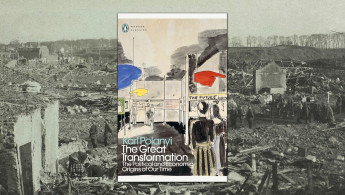Polanyi's The Great Transformation reveals why free markets don’t work the way we think
Karl Polanyi's 1944 work, The Great Transformation: The Political and Economic Origins of Our Time, exposes the myths of laissez-faire, which remains widespread in the West and elsewhere.
Looking at economic and other transformations during the Industrial Revolution and beyond, he showed that there is nothing inevitable and 'natural' about free markets, the ideological belief that they can solve most economic problems being utopian and dangerous.
JM Keynes, an important economic thinker of the last century, saw those in authority as distilling thoughts “from some academic scribbler of a few years back.” Indeed, his ideas underpin much economic policy today.
However, unlike Keynes who was an apologist for some form of capitalism, the less-remembered Polanyi’s “scribbling” shows that market fundamentalism, competition ideology, and social relations’ commodification contributed to fragilizing societies rather than enriching them, eventually leading to the upheavals of 1914-45 and later.
As for our present day, “the same risk applies” according to French economist Thomas Piketty.
With the global retreat of America and its free-market ideology, now is the time to rethink markets’ freedom.
Polanyi contends that the distinguishing characteristic of the “market society” underpinned by free enterprise is a changed economic mentality.
According to him, because of industrialization, competitive markets were created to shift social tendencies through institutions aiming for a self-regulating market economy.
From industrialization to modern crises
The expansion of the liberal mindset of capitalism also fundamentally altered economic relations among people. After industrialization, the myth of human nature's propensity toward free trade became widespread.
Polanyi asserts instead that an essential element for evolution from a premodern economy to a market one was the altering of human economic mentalities away from their grounding in local social relationships and institutions and into transactions idealized as rational and set apart from their previous context in society. (This recalls JK Galbraith, another great economist of the last century, whose focus on the post-WWII rise in Western affluence presented it as a qualitative and mixed change, not just a desirable quantitative phenomenon of higher incomes and more consumption.)
Polanyi refutes liberal accounts of capitalism’s rise by arguing that laissez-faire was planned. He does not deny that the self-regulating market brought vast material wealth in many cases but suggests that this focus is too narrow.
The market he notes, once it considers labour and land as commodities, subordinates the substance of society to its laws. This, Polanyi argues, results in massive social dislocation, eventually leading to spontaneous moves by society towards self-protection.
The changes Polanyi was looking at implied destruction of the social order that had reigned before the Industrial Revolution.
Central to the change was that land and labour would now be openly sold at market-determined prices instead of allocated according to tradition or some other non-market criteria.
Yet, the book also presents his belief that market society is unsustainable because it is destructive to humanity and its natural contexts.
Thus, a Polanyi Moment eventually happens when social protectionism starts to surpass marketization due to market collapse, as was the situation following the financial crash of 2008 and during the COVID-19 pandemic.
Insights into shock therapy and IMF reforms
From a contemporary global perspective, US economist Joseph Stiglitz favours the Polanyi account of market liberalization, arguing that the failures of “shock therapy” in Russia following the Cold War, and shortcomings in International Monetary Fund (IMF) reform packages, echo Polanyi's arguments.
Stiglitz also notes the difficulty of market liberalization in that it requires unrealistic flexibility by the poor being forced to accept austerity. (The Bretton Woods system, which tries to embed liberalism globally, through among other things the IMF, was launched in the same year that The Great Transformation was published.)
Polanyi's analysis helps explain why the resurgence of free market ideas resulted in and continues to lead to such manifest failures as persistent unemployment, widening inequality, and financial crises.
He witnessed such upheaval in his own time, from the First World War through the rise of communism, the coming of the Great Depression, and the onset of WWII, which was preceded by the emergence of fascism.
References to Palestine
Interestingly, one locus of the latter that he mentions in The Great Transformation was Palestine.
For him, a European Jew directly impacted by Nazi ideology, Zionism represented a retreat into fascistic isolation.
In 1934 Polanyi strongly repudiated the Zionists. "I will fight," he wrote, "against a revival of the Ghetto spirit which persecuted our ancestors.”
The woeful result of the Fascist-Zionist affinity which he identified is now even more apparent in Israeli aggression.
In conclusion, The Great Transformation is a corrective to widespread current global economic interpretation (an example of what Galbraith called the Conventional Wisdom) touted by America and imposed worldwide.
As such, the book should be read by economists, though the non-economist must not lightly attempt it.
Yet whatever the background of the reader, The Great Transformation resonates today, making this reissue (with a new introduction) timely.
Riad al Khouri is an independent Jordanian economist
Follow him on LinkedIn: Riad Al Khouri




 Follow the Middle East's top stories in English at The New Arab on Google News
Follow the Middle East's top stories in English at The New Arab on Google News


